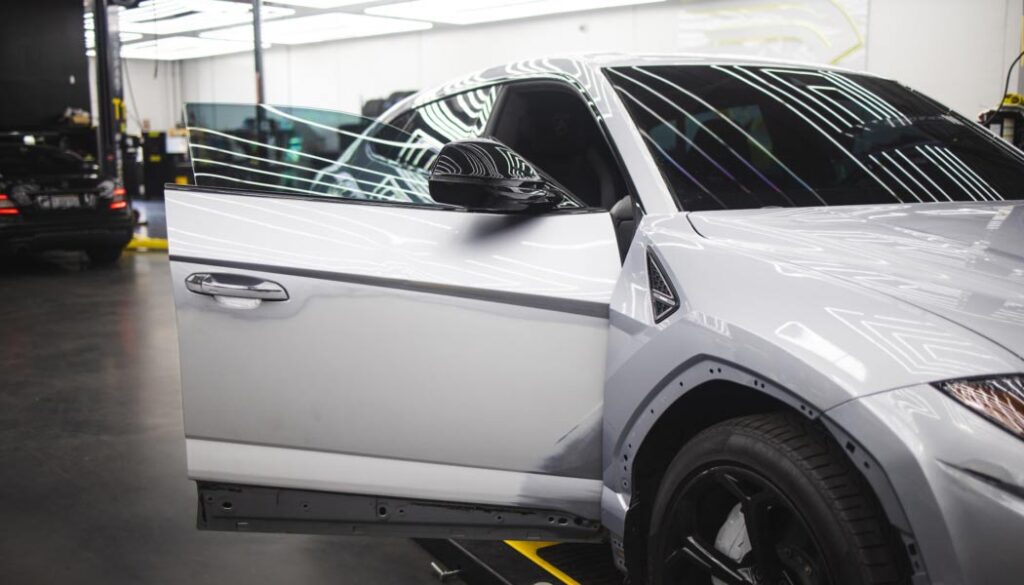
Will Acetone Damage Car Paint? [Protecting Your Car’s Paint]
Acetone can damage your car paint if applied improperly. Even, it can hurt clear coat and affect underlying paints as well. So, use it carefully.
Protecting the glossy sheen of your car’s paint job is crucial for maintaining its value and aesthetic appeal. But have you ever wondered if using acetone could potentially harm your car’s precious exterior?

In this article, we’ll explore the question: ‘will acetone damage car paint’.
Why Use Acetone on a Car?
Acetone is a commonly used chemical solvent that can have a few applications when it comes to cars. While acetone can be used for certain purposes, it should be handled with care. You should use it cautiously due to its flammability and potential to damage certain surfaces. Here are some potential benefits of using acetone on a car.
1. Paint and adhesive removal: Acetone can effectively dissolve and remove paint overspray, adhesive residue, or decals from the car surface. It can be particularly useful for removing stubborn or old paint layers or adhesive marks.
2. Surface preparation: Acetone can be used as a pre-painting surface preparation solvent. It can help remove oils, waxes, and other contaminants from the car’s surface. It provides a clean base for better paint adhesion.
3. Cleaning greasy residues: Acetone helps to clean greasy or sticky substances, such as tar or tree sap. Its strong solvent properties can help break down and remove these substances effectively.
Will Acetone Damage Car Paint?
Yes, acetone can damage car paint if used improperly or in excessive amounts. Acetone is a powerful solvent that is commonly used in various industrial and household applications. While it has some benefits for cleaning and removing certain substances, it can also cause significant harm to car paint.
When acetone comes into contact with car paint, it can dissolve the paint’s protective layer, leading to a loss of gloss and color. This is especially true for older or lower-quality paint finishes that may be more susceptible to damage. Acetone can strip away the clear coat. It can expose the underlying layers of paint and making them vulnerable to further damage.
One of the primary reasons acetone can be harmful to car paint is its ability to dissolve. It does not dissolve just dirt and grime, but also the protective waxes and sealants. These elements are commonly applied to maintain the paint’s appearance and protect it from environmental elements.
By removing these protective layers, acetone leaves the paint more vulnerable to fading. Plus, paint can face oxidation, and damage from UV rays, water, and other contaminants.
Additionally, acetone is a highly volatile and fast-evaporating solvent. If used in excessive amounts or left on surface for too long, it can cause the paint to dry out and become brittle. This can lead the paint to cracking and peeling.
Acetone can also affect the plastic and rubber components of a car, causing them to become discolored, deformed, or weakened.
Keep in mind that while acetone can cause damage, it can also be useful in certain situations. For instance, it can effectively remove adhesive residue left behind by stickers or decals on car surfaces.
Acetone can also be used to clean metal surfaces. It helps to prepare the surfaces for painting by removing oils and contaminants. However, when using acetone on a car’s paint, caution should be exercised to minimize the risks.
Potential Risks of Using Acetone on Car Paint
Using acetone on car paint can indeed pose several risks. Check the following risks associated with using acetone on car paint.
A. Paint Discoloration: Acetone can strip away the protective clear coat and remove the paint layers. It can cause the color to fade or become discolored, resulting in a patchy appearance on the car’s surface.
B. Damage to Clear Coat: The clear coat is a protective layer that provides shine and safeguards the underlying paint. Acetone can dissolve the clear coat and lead to its deterioration or complete removal. This can expose the paint to environmental factors, such as UV rays.
C. Impact on Other Materials: Acetone can harm other materials commonly found on cars, such as plastics, rubber, or vinyl trims. It can cause these materials to become brittle, crack, or discolor. Using acetone near these components can result in permanent damage to the car’s aesthetic.
D. Accidental Consequences: Incorrect application or misuse of acetone can lead to unintended consequences. For example, if acetone is left on the paint for too long, it can penetrate deep into the layers. As a result, it causes significant damage that may require professional intervention to fix. Additionally, acetone is highly flammable, so improper use or storage can pose fire hazards.
Factors That Determine Acetone’s Impact on Car Paint
When it comes to the impact of acetone on car paint, several factors come into play. Understanding these factors is crucial for maintaining the integrity and appearance of a vehicle’s paintwork. The factors that determine acetone’s impact on car paint include:
1. Composition of Car Paint
Car paint typically consists of multiple layers, including a primer, base coat, and clear coat. The vulnerability of each layer can vary based on the quality and composition of the paint.
Some car paints are more resistant to chemical exposure, while others may be more susceptible to damage. High-quality paints with a durable clear coat are generally more resistant to acetone compared to lower-quality paints.
2. Quality of the Paint Job
Original factory paint jobs are usually done using high-quality paints. It makes them more durable and resistant to various factors, including acetone.
On the other hand, aftermarket paint jobs may vary in quality, and the type of paint used can influence its resistance to acetone. Generally, original factory paint is more likely to withstand acetone exposure better than aftermarket paint.
3. Exposure Time
The duration of acetone exposure to car paint can affect the level of damage. Short-term contact with acetone may not cause significant harm to the paint if promptly and properly addressed.
However, prolonged exposure to acetone can increase the chances of damage, especially if the paint is of lower quality.
4. Concentration of Acetone
The concentration of acetone used can also impact its effect on car paint. Undiluted acetone solvents have a higher potential to cause damage compared to diluted solutions. It’s generally recommended to use mild and diluted acetone solutions for cleaning purposes.
However, even with diluted solutions, it’s essential to test a small, inconspicuous area before applying it to the entire paint surface to ensure compatibility.
How to Use Acetone on Car Paint Safely?
Using acetone on car paint can be risky if not done properly. However, if you follow these guidelines, you can use acetone safely.
A. Test on a Small Hidden Area: Before using acetone on the entire car surface, perform a patch test on a small, hidden area. This helps you determine if the acetone will damage or discolor the paint.
Choose an inconspicuous spot; apply a small amount of acetone. Observe the reaction after a few minutes. If there are no adverse effects, it should be safe to proceed.
B. Proper Dilution and Application: Acetone is a potent solvent, so it’s important to dilute it before use. Mix equal parts of acetone and water to create a diluted solution.
Avoid using undiluted acetone directly on the car paint, as it can cause serious damage. Apply the diluted acetone using a soft, clean cloth or sponge, and gently rub the stained area. Be cautious not to scrub too hard, as it may remove the paint.
C. Protective Measures: When working with acetone, take proper protective measures. Wear chemical-resistant gloves to protect your hands from direct contact with the solvent.
Additionally, use microfiber cloths for application, as they are gentle on the paint surface. Ensure that you perform your task in a well-ventilated area to avoid inhaling the fumes. The vapors of acetone can be harmful, so proper ventilation is surely essential.
D. Alternative Methods: If the stain on your car paint is stubborn and acetone doesn’t work, it’s advisable to explore safer alternatives. There are various commercial products available specifically designed to remove stains from car paint.
Look for products that are labeled as safe for automotive use and follow the instructions provided. You can also try using mild soapy water, automotive detailing clay, or specialized paint cleaners as alternative options.
Remember, even when using acetone correctly, there is still a risk of damaging the car paint. If you’re unsure or uncomfortable with using acetone, it’s best to consult a professional auto detailer for assistance.
How to Repair Acetone Damage on Car?
Accidents can happen, and if acetone comes into contact with your car’s paintwork, it can cause damage. If your car has suffered such acetone damage, here are some steps you can take to repair it.
1. Assessing the Damage
- Examine the surface where the acetone damage has occurred. Look for any discoloration, dullness, or roughness.
- Acetone can penetrate the clear coat and even the paint layer. Check if the damage is superficial or if it has reached the underlying layers.
2. Seek Professional Help
- If the acetone damage is severe, covers a large area, seek professional help from a car detailing expert.
- If you are unsure about your ability to fix the damage, consulting an expert can ensure a proper repair.
3. DIY Solutions for Minor Repairs
- Wash the damaged area with a mild car wash soap and water to remove any dirt, debris, or residual acetone.
- For minor damage, you can try using a light abrasive polish to buff out the affected area. Use a microfiber cloth or a polishing pad.
- If the damage has gone through the paint layer, you may need to perform spot touch-ups. Find a touch-up paint that matches your car’s color. Carefully apply it to the damaged area.
- After the repair, use a polishing compound and a soft cloth to restore the shine of the repaired area. Finish by applying a coat of wax to protect the paint.
4. Preventive Measures
- Keep your car away from substances that contain acetone, such as paint thinners and some cleaning agents.
- If you accidentally spill acetone on your car, clean it immediately to minimize the potential damage.
- Apply a good quality car wax periodically to provide a protective layer on the paint.
Does Acetone Remove Car Paint?
Yes, acetone can remove car paint. Acetone can dissolve many types of paints and coatings, including automotive paint. It is commonly used in paint thinners and removers due to its ability to break down paint molecules.
If you plan using acetone to remove car paint, apply it to a clean cloth and gently rub the affected area in a circular motion. Test a small area first to ensure that the acetone does not cause any adverse effects on the car’s paint. After using acetone, wash and wax the car’s surface.
Will Acetone Remove Clear Coat?
Acetone can also remove clear coat. Clear coat is a transparent layer applied to the top of automotive paint to protect it and give it a glossy appearance.
Highly-concentrated acetone can remove clear coat. Note that this type can be very strong solvent and can also damage the underlying paint. So, use it with caution and only in small amounts.
Final Thoughts
It is important to recognize that acetone can damage car paint. While modern automotive paints have become more resistant to solvents, acetone’s powerful properties can still pose a risk if used improperly. To maintain the integrity of your car’s paint job, it is advisable to exercise caution.
Use appropriate cleaning agents, and consult professionals when in doubt to preserve the appearance of your car’s paint.
